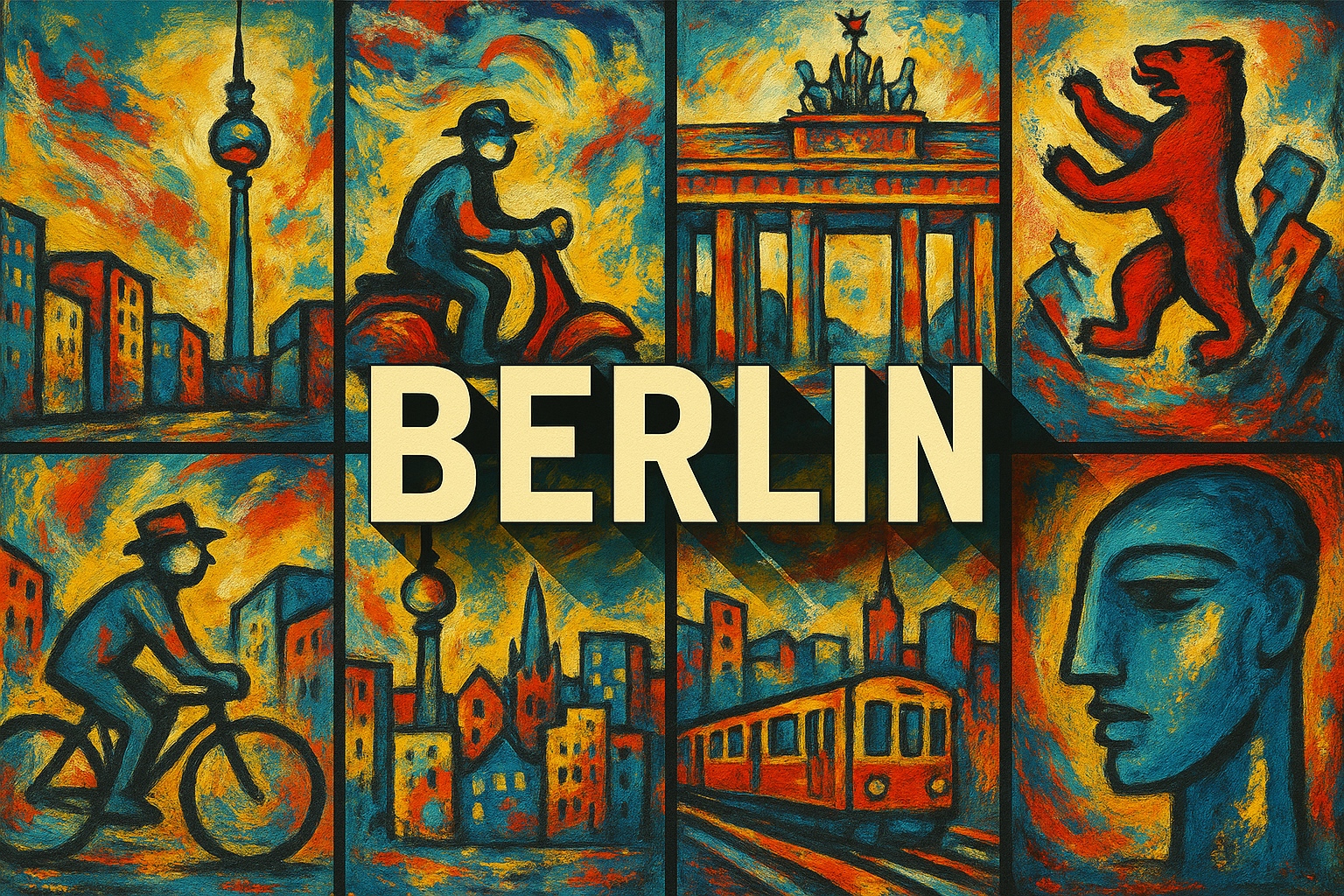
Berlin
The art style Berlin is characterized by its use of bright colors and bold patterns. Berlin artists often use geometric shapes and patterns to create their artworks.
AOI thinking about Berlin [+_~]-/
Overview and Quickfacts
The Berlin art scene is known for its cutting-edge, contemporary art. The city is home to a number of world-renowned art galleries and museums, as well as a thriving street art scene. Berlin artists are often at the forefront of new and innovative art movements, and the city is a hotbed of creative talent.
Can understand it also, as:
Germany, city, capital
Categorize it as:
Impressionism, Modernism
.: Dreaming :.
holds a HAIKU for the art style
:. Thought is power .:
Detailed Description
When thinking of the art scene in Berlin, one of the first things that comes to mind is the Berlin Wall. The Berlin Wall was a physical division between East and West Berlin during the Cold War. It was also a symbol of the ideological division between communism and capitalism. The Berlin Wall fell in 1989, and since then, Berlin has been a unified city. The art scene in Berlin is very diverse. There are many different styles and genres of art represented in the city. Berlin is home to many famous artists, such as Max Beckmann, Otto Dix, and George Grosz. These artists were part of the Expressionist movement, which was a response to the horrors of World War I. Other famous artists from Berlin include Anselm Kiefer and Gerhard Richter. Kiefer is known for his large-scale, often abstract paintings. Richter is a leading figure in the field of photo-realism. There are many art museums and galleries in Berlin. The Berlin State Museums are a group of museums that include the Alte Nationalgalerie, the Neue Nationalgalerie, and the Bode Museum. The Alte Nationalgalerie is home to a collection of 19th-century art, including works by Caspar David Friedrich, Karl Friedrich Schinkel, and Auguste Rodin. The Neue Nationalgalerie is a museum of 20th-century art, with a focus on German artists. The Bode Museum is a museum of art and archaeology with a collection that spans from antiquity to the early 20th century. The Berlin art scene is not limited to traditional art museums and galleries. There are also many contemporary art galleries in the city. These galleries showcase the work of contemporary artists from all over the world. If you’re interested in the art scene in Berlin, there are many ways to get involved. There are art classes and workshops offered at many of the city’s museums and galleries. There are also many art festivals and events that take place throughout the year.
.. beep, beep, beep ..
<START OF TRANSMISSION>
1. Berlin is the capital of Germany. 2. It is also the largest city in Germany with a population of over 3.5 million people. 3. Berlin is located in the northeastern part of Germany. 4. The city has a temperate climate with cool winters and warm summers. 5. Berlin is a major cultural center in Europe with many museums, theaters, and other institutions. 6. The city is also home to many universities and other educational institutions. 7. Berlin is the seat of the German government and the site of the German parliament. 8. The city is also the capital of the state of Berlin. 9. Berlin is a major transportation hub with an international airport and many railway lines. 10. The city is also home to a large number of businesses and industries. 11. Berlin has a long history dating back to the 13th century. 12. The city has been the capital of Germany since 1871. 13. Berlin was the site of the Nazi regime during World War II. 14. The city was divided into East and West Berlin during the Cold War. 15. Berlin was reunified in 1990 after the fall of the Berlin Wall. 16. The city has undergone a major transformation since reunification. 17. Berlin is now one of the most vibrant and cosmopolitan cities in Europe. 18. The city is also home to a large number of immigrants from all over the world. 19. Berlin is a major tourist destination with many attractions and events. 20. The city is also an important center for politics, economics, and culture.
<EOF>
.. robbel bob
Visual Examples from our image gallery
Coming soon, we are so slow .. might never come
Artists, Paintings, and more
(be aware, can be highly speculative)
Artists (be aware, speculation possible):
1. Max Beckmann (1884-1950) 2. George Grosz (1893-1959) 3. Otto Dix (1891-1969) 4. Hannah HÃÂöch (1889-1978) 5. Ernst Kirchner (1880-1938) 6. August Macke (1887-1914) 7. Franz Marc (1880-1916) 8. Oskar Kokoschka (1886-1980) 9. Max Pechstein (1881-1955) 10. Christian Schad (1894-1982) 11. Rudolf Schlichter (1890-1955) 12. Kurt Schwitters (1887-1948) 13. GÃÂünther Uecker (1930-present) 14. Wolf Vostell (1932-1998) 15. Ema Ziegler (1894-1941)
Artworks (be aware, speculation possible)
1. The Berlin Wall, by graffiti artist Thierry Noir (1984) 2. The Brandenburg Gate, by Karl Friedrich Schinkel (1815) 3. The Reichstag, by Ernst von Ihne (1872) 4. The Victory Column, by Heinrich von ZÃÂügel (1873) 5. The Berliner Dom, by Karl Friedrich Schinkel (1822-1833) 6. The Alte Nationalgalerie, by Karl Friedrich Schinkel (1848) 7. The Berliner Fernsehturm, by Hermann Henselmann (1969) 8. The Bauhaus-Archiv, by Walter Gropius (1963) 9. The Charlottenburg Palace, by Johann Friedrich Eosander (1695-1747) 10. The Pergamon Museum, by Alfred Messel and Ludwig Hoffmann (1903-1930) 11. The Berlin Zoo, by Peter Joseph LennÃÂé (1844) 12. The KurfÃÂürstendamm, by Ernst Ludwig Kirchner (1907) 13. The Potsdamer Platz, by Karl Friedrich Schinkel (1827) 14. The SiegessÃÂäule, by Johann Heinrich Strack (1873-1883) 15. The Staatsoper Unter den Linden, by Karl Friedrich Schinkel (1841)
Epoch
The Berlin art style dates back to the early 20th century.
AI ART RESSOURCES (AKA, well Tools)
Helping tools -> predefined search links on other pages:











